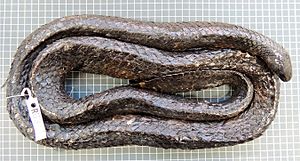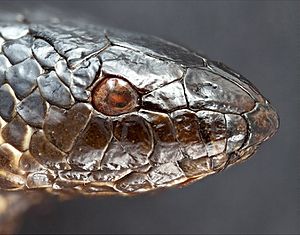Short-nosed sea snake facts for kids
Quick facts for kids Short-nosed sea snake |
|
|---|---|
 |
|
| Museum specimen | |
| Conservation status | |
| Scientific classification | |
| Genus: |
Aipysurus
|
| Species: |
apraefrontalis
|
The short-nosed sea snake (also known as Aipysurus apraefrontalis) is a special type of sea snake. It is a critically endangered animal, meaning it is very close to disappearing forever. These snakes are venomous and belong to the Elapidae family. They live on coral reefs near the northern coast of Western Australia. An English scientist named Malcolm Arthur Smith first described this snake in 1926. He found a specimen on the Ashmore Reef.
Contents
About the Short-Nosed Sea Snake
Short-nosed sea snakes are usually brown and slender. They can grow up to about 60 centimeters (24 inches) long. Their head is quite small and has a pointed shape. You can also see darker purplish-brown bands along their body. These snakes live for a long time and grow slowly. Scientists are still learning about when they become old enough to have babies.
They prefer to live in water that is deeper than 10 meters (33 feet). However, during the day, they like to rest under coral ledges in shallower water, less than 2 meters (6.5 feet) deep. They hunt for food on reef flats. Their venom is very strong, and they use it to catch their prey. Scientists believe that short-nosed sea snakes mainly eat eels. They also eat small fish like gobies.
How They Breathe and Live in Water
Sea snakes breathe air, just like us. They come to the surface to take a breath. When they dive underwater, they close their nostrils. They can hold their breath for up to two hours! These snakes have only one lung, which is long and shaped like a tube. It stretches almost the entire length of their body.
But that's not the only way they get oxygen. They can also absorb oxygen through their skin. To keep their skin healthy and free of things that might stick to it, they shed their skin more often than land snakes do. Short-nosed sea snakes are ovoviviparous. This means they give birth to live young, but the babies grow inside eggs that stay inside the mother's body until they hatch. Their whole life cycle, including having babies, happens completely in the ocean. They also have a special gland under their tongue that helps them get rid of extra salt from the seawater.
Where They Live and Their Status
The short-nosed sea snake is found near the Ashmore and Cartier Islands and the Ningaloo Reef. Both of these places are off the coast of Northwestern Australia. For a long time, scientists thought these snakes only had babies on Ashmore Reef. In fact, they hadn't been seen there for 15 years, and people worried they might be gone forever.
However, a study in 2015 brought good news. It found that short-nosed sea snakes found in Exmouth Gulf, and near Roebourne and Broome, were actually different groups of snakes that were also having babies. They weren't just snakes that had wandered from other places. In December 2015, a pair of snakes was even seen courting at Ningaloo Reef. This suggests that there might be another group of these snakes living and having babies there too.
Threats to Their Survival
Several things are making it hard for the short-nosed sea snake to survive. Warmer ocean temperatures are a big problem. Also, commercial fishing boats that use large nets to catch prawns can accidentally catch these snakes. Many snakes caught in these nets die from injuries or by drowning.
Other dangers include oil spills, dirty water, and activities like dredging (digging up the seabed). More boats in the water can also disturb or harm them. The reasons for their decline are complicated. It's likely connected to problems in the entire ocean ecosystem where they live. These snakes also have a slow reproduction rate. They have only a few babies at a time, and many young snakes do not survive. Female snakes also don't have babies every year.
See also
 In Spanish: Serpiente marina de hocico corto para niños
In Spanish: Serpiente marina de hocico corto para niños



